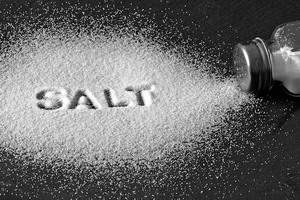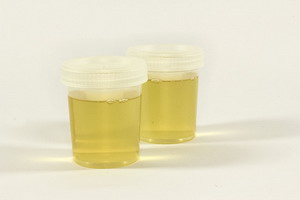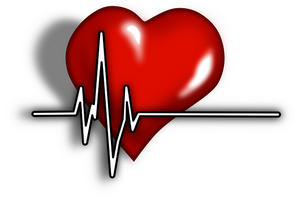 About a hundred years ago, we had a big problem in this country — goiter. Back then about one-third of Americans had this disease! This is one of the late-stage manifestations of iodine deficiency. What is goiter? It is a swelling of the thyroid gland in your neck just above your collarbone. While this is unsightly, the consequence of this thyroid dysfunction is quite severe. Probably the worst consequence is what happens to children born of mothers who are iodine deficient — cretinism. The term has fallen out of favor over the last number of years, but medically it refers to the combination of mental retardation and short stature. You see, iodine is vital for the normal growth of every tissue in the body. In particular, the brain needs iodine as well as all your hormonal glands. Lacking sufficient iodine during your growth years results in about a one standard deviation drop in your intelligence, or about 15 IQ points. Since the average person has an IQ of 100, by definition someone with an iodine deficiency will average around 85 IQ points. One way to understand that is by age equivalents. An IQ of 85 means the person functions at about the capacity of an average 11-year-old. Doing the math tells us that one-third of American adults back then were functioning at the mental capacity of an 11-year-old. About a hundred years ago, we had a big problem in this country — goiter. Back then about one-third of Americans had this disease! This is one of the late-stage manifestations of iodine deficiency. What is goiter? It is a swelling of the thyroid gland in your neck just above your collarbone. While this is unsightly, the consequence of this thyroid dysfunction is quite severe. Probably the worst consequence is what happens to children born of mothers who are iodine deficient — cretinism. The term has fallen out of favor over the last number of years, but medically it refers to the combination of mental retardation and short stature. You see, iodine is vital for the normal growth of every tissue in the body. In particular, the brain needs iodine as well as all your hormonal glands. Lacking sufficient iodine during your growth years results in about a one standard deviation drop in your intelligence, or about 15 IQ points. Since the average person has an IQ of 100, by definition someone with an iodine deficiency will average around 85 IQ points. One way to understand that is by age equivalents. An IQ of 85 means the person functions at about the capacity of an average 11-year-old. Doing the math tells us that one-third of American adults back then were functioning at the mental capacity of an 11-year-old.
 This was a problem. The source of the problem was the iodine-poor soils where the crops were grown. Poor soil means the plants and the animals grazed on those plants were low in iodine. When you map out those iodine-poor soil areas in the US, it basically looks like all of the upper half of the US from the top of California and north straight across the US. The areas within a hundred miles of the eastern coast are spared. Iodine is carried inland on the warm ocean air, so the East Coast is spared while the cold Pacific currents don’t provide the same iodine levels until things warm up a bit along the California coast. This was a problem. The source of the problem was the iodine-poor soils where the crops were grown. Poor soil means the plants and the animals grazed on those plants were low in iodine. When you map out those iodine-poor soil areas in the US, it basically looks like all of the upper half of the US from the top of California and north straight across the US. The areas within a hundred miles of the eastern coast are spared. Iodine is carried inland on the warm ocean air, so the East Coast is spared while the cold Pacific currents don’t provide the same iodine levels until things warm up a bit along the California coast.
 Our government actually responded in a fairly intelligent manner once they figured this out. They instituted the addition of iodine into salt. They experimented to find out how much iodine was needed to prevent goiter and added that to the average amount of salt that folks ate per day back then. This was great and responsible for a gradual increase in the American IQ for the next couple of decades. Unfortunately, the research did not go beyond looking at the goiter of the thyroid. It did not look at the actual iodine needs of the whole body. All the rest of the steroidal hormone glands (ovaries, testes, breasts, adrenals, prostate, etc.) suck up a lot of iodine daily. Nevertheless, iodized salt was a great boon until the doctors started telling us to stop eating salt. So now where do we get our iodine? Our government actually responded in a fairly intelligent manner once they figured this out. They instituted the addition of iodine into salt. They experimented to find out how much iodine was needed to prevent goiter and added that to the average amount of salt that folks ate per day back then. This was great and responsible for a gradual increase in the American IQ for the next couple of decades. Unfortunately, the research did not go beyond looking at the goiter of the thyroid. It did not look at the actual iodine needs of the whole body. All the rest of the steroidal hormone glands (ovaries, testes, breasts, adrenals, prostate, etc.) suck up a lot of iodine daily. Nevertheless, iodized salt was a great boon until the doctors started telling us to stop eating salt. So now where do we get our iodine?
 We have another problem no one is talking about – bromine. Bromine is a cousin to iodine and it likes to replace iodine in the body by kicking the iodine out of its useful spots. Around 1980 the US started to replace potassium iodate as a bread dough conditioner and we started bleaching our flour with bromine. This makes the flour much easier for bakers to work with. However, not only is bromine toxic, and cancer-causing, but it messes up our iodine levels. Most countries have banned bromine bleaching agents, but not us. Just last year California decided to start a ban beginning in 2027. Many doctors feel the bromine in our diets is causing a host of glandular diseases because of how it alters our iodine levels. Another cousin to iodine that also causes similar issues to bromine is fluorine, as in fluoride in our water supply. We have another problem no one is talking about – bromine. Bromine is a cousin to iodine and it likes to replace iodine in the body by kicking the iodine out of its useful spots. Around 1980 the US started to replace potassium iodate as a bread dough conditioner and we started bleaching our flour with bromine. This makes the flour much easier for bakers to work with. However, not only is bromine toxic, and cancer-causing, but it messes up our iodine levels. Most countries have banned bromine bleaching agents, but not us. Just last year California decided to start a ban beginning in 2027. Many doctors feel the bromine in our diets is causing a host of glandular diseases because of how it alters our iodine levels. Another cousin to iodine that also causes similar issues to bromine is fluorine, as in fluoride in our water supply.
 What are the typical symptoms of low iodine levels? The most obvious symptoms are related to low thyroid hormone levels since iodine is the key element in the formation of the thyroid hormone. Symptoms:Fatigue
Hair loss
Dry skin
Swollen neck
Brain fog
Fibrocystic breast disease
Hormone imbalances
Lower body temperature
 The last symptom is often the first and simplest sign to look for. Midday your body temperature should be 98.6 degrees. If it is lower than that, often there is a good chance that you are iodine deficient. Iodine, via thyroid hormone, is what governs your body’s generation of energy, including the energy to keep your body warm. All the chemistry that keeps us alive operates at a very specific temperature, 98.6 degrees. When our temperature is higher or lower, our body simply does not function as well. So I recommend you check your temperature either just before lunch or a couple hours after lunch to find out your basic body temperature. Eating causes the temperature at your surface to drop because your blood centers in your gut to help you digest your food, so avoid taking your temperature right after you have eaten. The last symptom is often the first and simplest sign to look for. Midday your body temperature should be 98.6 degrees. If it is lower than that, often there is a good chance that you are iodine deficient. Iodine, via thyroid hormone, is what governs your body’s generation of energy, including the energy to keep your body warm. All the chemistry that keeps us alive operates at a very specific temperature, 98.6 degrees. When our temperature is higher or lower, our body simply does not function as well. So I recommend you check your temperature either just before lunch or a couple hours after lunch to find out your basic body temperature. Eating causes the temperature at your surface to drop because your blood centers in your gut to help you digest your food, so avoid taking your temperature right after you have eaten.
 Is there a lab test way to check your iodine levels? It was almost 50 years after they started putting iodine into salt that they finally figured out a way to test iodine levels. This is done by giving you a big dose of iodine, 50mg, and collecting your urine for 24 hours. By measuring how much iodine is excreted in your urine, you can determine how much iodine your body is retaining for its needs. You should excrete 90% of that iodine. Dr. Brownstein has written several books on iodine and has found in performing over 10,000 such tests on patients that typically they excrete less than half of that 50mg iodine. This finding has led him to recommend the average person take 25mg of iodine per day. Back in 1923, the recommendation was 150 micrograms to stop goiter, but they had no idea how much people needed to be healthy. They just knew how much was needed to stop goiter. This is a common problem with vitamin research. Typically researchers guess that what we need is less than 10 times what is needed to stop a deficiency disease. So that is what they recommend. It’s pure guesswork. Optimum health means you might need 1000 times more than what is needed to stop disease. The more modern kidney iodine clearance test seems to say we need that much higher dose. From Dr. Brownstein’s experience with both hypothyroid and hyperthyroid patients, they often need much higher doses for a short period. He “cured” his daughter’s Hashimoto’s autoimmune disease this way. Is there a lab test way to check your iodine levels? It was almost 50 years after they started putting iodine into salt that they finally figured out a way to test iodine levels. This is done by giving you a big dose of iodine, 50mg, and collecting your urine for 24 hours. By measuring how much iodine is excreted in your urine, you can determine how much iodine your body is retaining for its needs. You should excrete 90% of that iodine. Dr. Brownstein has written several books on iodine and has found in performing over 10,000 such tests on patients that typically they excrete less than half of that 50mg iodine. This finding has led him to recommend the average person take 25mg of iodine per day. Back in 1923, the recommendation was 150 micrograms to stop goiter, but they had no idea how much people needed to be healthy. They just knew how much was needed to stop goiter. This is a common problem with vitamin research. Typically researchers guess that what we need is less than 10 times what is needed to stop a deficiency disease. So that is what they recommend. It’s pure guesswork. Optimum health means you might need 1000 times more than what is needed to stop disease. The more modern kidney iodine clearance test seems to say we need that much higher dose. From Dr. Brownstein’s experience with both hypothyroid and hyperthyroid patients, they often need much higher doses for a short period. He “cured” his daughter’s Hashimoto’s autoimmune disease this way.

What else can cause us to have low iodine levels? We have talked about poor soil in the goiter belt region of America, and we have talked about exposure to bromine and fluorine which is in everything from frying pans to the fire retardants in our furniture. Other things that lower iodine include pregnancy (because the baby needs so much), smoking, alcohol, contraceptives, goitrogens, and selenium deficiency. Goitrogens are foods that block iodine uptake by the thyroid and include cabbage family veggies, soy, millet, and cassava. If your iodine levels are low these can have an important effect. Thyroid hormone contains both iodine and selenium because selenium is necessary for the iodine to be properly used. Low selenium levels produce the effect of low iodine utilization. We need to consume at least 200 micrograms of selenium per day, but unfortunately, plant sources such as Brazil nuts are poorly utilized. Selenium is also essential for the formation of glutathione; the body’s master antioxidant.
 So how can we increase our intake of iodine? Typically iodine is found in seafood and seaweeds. These sources will keep us from developing goiter. To get the levels the kidney clearance tests suggest we need, we need to supplement with iodine drops. Lugol’s solution has been around for a couple hundred years and it contains both iodine and potassium iodide. The typical 2% solution of Lugol’s iodine will provide 2.5mg of iodine per drop. If your kidneys are working well, Lugol’s iodine is very safe as any excess is passed out in the urine. Taking amounts over 1 gram per day can overload the kidneys and produce problems. Do not use medical providone iodine (Betadine) as it contains a polyvinyl carrier molecule. Dosage suggestions I have encountered recommend starting with one drop a day and increasing that by one more drop every 2 weeks until you get to 10 drops per day. This just gives the body time to adjust to the improved levels of iodine. So how can we increase our intake of iodine? Typically iodine is found in seafood and seaweeds. These sources will keep us from developing goiter. To get the levels the kidney clearance tests suggest we need, we need to supplement with iodine drops. Lugol’s solution has been around for a couple hundred years and it contains both iodine and potassium iodide. The typical 2% solution of Lugol’s iodine will provide 2.5mg of iodine per drop. If your kidneys are working well, Lugol’s iodine is very safe as any excess is passed out in the urine. Taking amounts over 1 gram per day can overload the kidneys and produce problems. Do not use medical providone iodine (Betadine) as it contains a polyvinyl carrier molecule. Dosage suggestions I have encountered recommend starting with one drop a day and increasing that by one more drop every 2 weeks until you get to 10 drops per day. This just gives the body time to adjust to the improved levels of iodine.
In line with this advice, I have stocked Lugol’s 2% iodine at the office for those of you who wish to improve your iodine levels.
Take care,
David
Ellen
 Here we see Ellen with her new transport chair. Her old chair served her well for many years, but recently one of the wheels started wobbling due to the bearings wearing out. It was time to spring for a new chair. This one has bigger wheels that glide sommthly across the room and over those little bumps in life that always seen to show up. Here we see Ellen with her new transport chair. Her old chair served her well for many years, but recently one of the wheels started wobbling due to the bearings wearing out. It was time to spring for a new chair. This one has bigger wheels that glide sommthly across the room and over those little bumps in life that always seen to show up.
|

 Tylenol disrupts the heart
Tylenol disrupts the heart
 Herbs for ulcerative colitis
Herbs for ulcerative colitis
 Blessed thistle extract speeds nerve healing
Blessed thistle extract speeds nerve healing

 About a hundred years ago, we had a big problem in this country — goiter. Back then about one-third of Americans had this disease! This is one of the late-stage manifestations of iodine deficiency. What is goiter? It is a swelling of the thyroid gland in your neck just above your collarbone. While this is unsightly, the consequence of this thyroid dysfunction is quite severe. Probably the worst consequence is what happens to children born of mothers who are iodine deficient — cretinism. The term has fallen out of favor over the last number of years, but medically it refers to the combination of mental retardation and short stature. You see, iodine is vital for the normal growth of every tissue in the body. In particular, the brain needs iodine as well as all your hormonal glands. Lacking sufficient iodine during your growth years results in about a one standard deviation drop in your intelligence, or about 15 IQ points. Since the average person has an IQ of 100, by definition someone with an iodine deficiency will average around 85 IQ points. One way to understand that is by age equivalents. An IQ of 85 means the person functions at about the capacity of an average 11-year-old. Doing the math tells us that one-third of American adults back then were functioning at the mental capacity of an 11-year-old.
About a hundred years ago, we had a big problem in this country — goiter. Back then about one-third of Americans had this disease! This is one of the late-stage manifestations of iodine deficiency. What is goiter? It is a swelling of the thyroid gland in your neck just above your collarbone. While this is unsightly, the consequence of this thyroid dysfunction is quite severe. Probably the worst consequence is what happens to children born of mothers who are iodine deficient — cretinism. The term has fallen out of favor over the last number of years, but medically it refers to the combination of mental retardation and short stature. You see, iodine is vital for the normal growth of every tissue in the body. In particular, the brain needs iodine as well as all your hormonal glands. Lacking sufficient iodine during your growth years results in about a one standard deviation drop in your intelligence, or about 15 IQ points. Since the average person has an IQ of 100, by definition someone with an iodine deficiency will average around 85 IQ points. One way to understand that is by age equivalents. An IQ of 85 means the person functions at about the capacity of an average 11-year-old. Doing the math tells us that one-third of American adults back then were functioning at the mental capacity of an 11-year-old. This was a problem. The source of the problem was the iodine-poor soils where the crops were grown. Poor soil means the plants and the animals grazed on those plants were low in iodine. When you map out those iodine-poor soil areas in the US, it basically looks like all of the upper half of the US from the top of California and north straight across the US. The areas within a hundred miles of the eastern coast are spared. Iodine is carried inland on the warm ocean air, so the East Coast is spared while the cold Pacific currents don’t provide the same iodine levels until things warm up a bit along the California coast.
This was a problem. The source of the problem was the iodine-poor soils where the crops were grown. Poor soil means the plants and the animals grazed on those plants were low in iodine. When you map out those iodine-poor soil areas in the US, it basically looks like all of the upper half of the US from the top of California and north straight across the US. The areas within a hundred miles of the eastern coast are spared. Iodine is carried inland on the warm ocean air, so the East Coast is spared while the cold Pacific currents don’t provide the same iodine levels until things warm up a bit along the California coast. Our government actually responded in a fairly intelligent manner once they figured this out. They instituted the addition of iodine into salt. They experimented to find out how much iodine was needed to prevent goiter and added that to the average amount of salt that folks ate per day back then. This was great and responsible for a gradual increase in the American IQ for the next couple of decades. Unfortunately, the research did not go beyond looking at the goiter of the thyroid. It did not look at the actual iodine needs of the whole body. All the rest of the steroidal hormone glands (ovaries, testes, breasts, adrenals, prostate, etc.) suck up a lot of iodine daily. Nevertheless, iodized salt was a great boon until the doctors started telling us to stop eating salt. So now where do we get our iodine?
Our government actually responded in a fairly intelligent manner once they figured this out. They instituted the addition of iodine into salt. They experimented to find out how much iodine was needed to prevent goiter and added that to the average amount of salt that folks ate per day back then. This was great and responsible for a gradual increase in the American IQ for the next couple of decades. Unfortunately, the research did not go beyond looking at the goiter of the thyroid. It did not look at the actual iodine needs of the whole body. All the rest of the steroidal hormone glands (ovaries, testes, breasts, adrenals, prostate, etc.) suck up a lot of iodine daily. Nevertheless, iodized salt was a great boon until the doctors started telling us to stop eating salt. So now where do we get our iodine? We have another problem no one is talking about – bromine. Bromine is a cousin to iodine and it likes to replace iodine in the body by kicking the iodine out of its useful spots. Around 1980 the US started to replace potassium iodate as a bread dough conditioner and we started bleaching our flour with bromine. This makes the flour much easier for bakers to work with. However, not only is bromine toxic, and cancer-causing, but it messes up our iodine levels. Most countries have banned bromine bleaching agents, but not us. Just last year California decided to start a ban beginning in 2027. Many doctors feel the bromine in our diets is causing a host of glandular diseases because of how it alters our iodine levels. Another cousin to iodine that also causes similar issues to bromine is fluorine, as in fluoride in our water supply.
We have another problem no one is talking about – bromine. Bromine is a cousin to iodine and it likes to replace iodine in the body by kicking the iodine out of its useful spots. Around 1980 the US started to replace potassium iodate as a bread dough conditioner and we started bleaching our flour with bromine. This makes the flour much easier for bakers to work with. However, not only is bromine toxic, and cancer-causing, but it messes up our iodine levels. Most countries have banned bromine bleaching agents, but not us. Just last year California decided to start a ban beginning in 2027. Many doctors feel the bromine in our diets is causing a host of glandular diseases because of how it alters our iodine levels. Another cousin to iodine that also causes similar issues to bromine is fluorine, as in fluoride in our water supply. The last symptom is often the first and simplest sign to look for. Midday your body temperature should be 98.6 degrees. If it is lower than that, often there is a good chance that you are iodine deficient. Iodine, via thyroid hormone, is what governs your body’s generation of energy, including the energy to keep your body warm. All the chemistry that keeps us alive operates at a very specific temperature, 98.6 degrees. When our temperature is higher or lower, our body simply does not function as well. So I recommend you check your temperature either just before lunch or a couple hours after lunch to find out your basic body temperature. Eating causes the temperature at your surface to drop because your blood centers in your gut to help you digest your food, so avoid taking your temperature right after you have eaten.
The last symptom is often the first and simplest sign to look for. Midday your body temperature should be 98.6 degrees. If it is lower than that, often there is a good chance that you are iodine deficient. Iodine, via thyroid hormone, is what governs your body’s generation of energy, including the energy to keep your body warm. All the chemistry that keeps us alive operates at a very specific temperature, 98.6 degrees. When our temperature is higher or lower, our body simply does not function as well. So I recommend you check your temperature either just before lunch or a couple hours after lunch to find out your basic body temperature. Eating causes the temperature at your surface to drop because your blood centers in your gut to help you digest your food, so avoid taking your temperature right after you have eaten. Is there a lab test way to check your iodine levels? It was almost 50 years after they started putting iodine into salt that they finally figured out a way to test iodine levels. This is done by giving you a big dose of iodine, 50mg, and collecting your urine for 24 hours. By measuring how much iodine is excreted in your urine, you can determine how much iodine your body is retaining for its needs. You should excrete 90% of that iodine. Dr. Brownstein has written several books on iodine and has found in performing over 10,000 such tests on patients that typically they excrete less than half of that 50mg iodine. This finding has led him to recommend the average person take 25mg of iodine per day. Back in 1923, the recommendation was 150 micrograms to stop goiter, but they had no idea how much people needed to be healthy. They just knew how much was needed to stop goiter. This is a common problem with vitamin research. Typically researchers guess that what we need is less than 10 times what is needed to stop a deficiency disease. So that is what they recommend. It’s pure guesswork. Optimum health means you might need 1000 times more than what is needed to stop disease. The more modern kidney iodine clearance test seems to say we need that much higher dose. From Dr. Brownstein’s experience with both hypothyroid and hyperthyroid patients, they often need much higher doses for a short period. He “cured” his daughter’s Hashimoto’s autoimmune disease this way.
Is there a lab test way to check your iodine levels? It was almost 50 years after they started putting iodine into salt that they finally figured out a way to test iodine levels. This is done by giving you a big dose of iodine, 50mg, and collecting your urine for 24 hours. By measuring how much iodine is excreted in your urine, you can determine how much iodine your body is retaining for its needs. You should excrete 90% of that iodine. Dr. Brownstein has written several books on iodine and has found in performing over 10,000 such tests on patients that typically they excrete less than half of that 50mg iodine. This finding has led him to recommend the average person take 25mg of iodine per day. Back in 1923, the recommendation was 150 micrograms to stop goiter, but they had no idea how much people needed to be healthy. They just knew how much was needed to stop goiter. This is a common problem with vitamin research. Typically researchers guess that what we need is less than 10 times what is needed to stop a deficiency disease. So that is what they recommend. It’s pure guesswork. Optimum health means you might need 1000 times more than what is needed to stop disease. The more modern kidney iodine clearance test seems to say we need that much higher dose. From Dr. Brownstein’s experience with both hypothyroid and hyperthyroid patients, they often need much higher doses for a short period. He “cured” his daughter’s Hashimoto’s autoimmune disease this way.
 So how can we increase our intake of iodine? Typically iodine is found in seafood and seaweeds. These sources will keep us from developing goiter. To get the levels the kidney clearance tests suggest we need, we need to supplement with iodine drops. Lugol’s solution has been around for a couple hundred years and it contains both iodine and potassium iodide. The typical 2% solution of Lugol’s iodine will provide 2.5mg of iodine per drop. If your kidneys are working well, Lugol’s iodine is very safe as any excess is passed out in the urine. Taking amounts over 1 gram per day can overload the kidneys and produce problems. Do not use medical providone iodine (Betadine) as it contains a polyvinyl carrier molecule. Dosage suggestions I have encountered recommend starting with one drop a day and increasing that by one more drop every 2 weeks until you get to 10 drops per day. This just gives the body time to adjust to the improved levels of iodine.
So how can we increase our intake of iodine? Typically iodine is found in seafood and seaweeds. These sources will keep us from developing goiter. To get the levels the kidney clearance tests suggest we need, we need to supplement with iodine drops. Lugol’s solution has been around for a couple hundred years and it contains both iodine and potassium iodide. The typical 2% solution of Lugol’s iodine will provide 2.5mg of iodine per drop. If your kidneys are working well, Lugol’s iodine is very safe as any excess is passed out in the urine. Taking amounts over 1 gram per day can overload the kidneys and produce problems. Do not use medical providone iodine (Betadine) as it contains a polyvinyl carrier molecule. Dosage suggestions I have encountered recommend starting with one drop a day and increasing that by one more drop every 2 weeks until you get to 10 drops per day. This just gives the body time to adjust to the improved levels of iodine. Here we see Ellen with her new transport chair. Her old chair served her well for many years, but recently one of the wheels started wobbling due to the bearings wearing out. It was time to spring for a new chair. This one has bigger wheels that glide sommthly across the room and over those little bumps in life that always seen to show up.
Here we see Ellen with her new transport chair. Her old chair served her well for many years, but recently one of the wheels started wobbling due to the bearings wearing out. It was time to spring for a new chair. This one has bigger wheels that glide sommthly across the room and over those little bumps in life that always seen to show up.